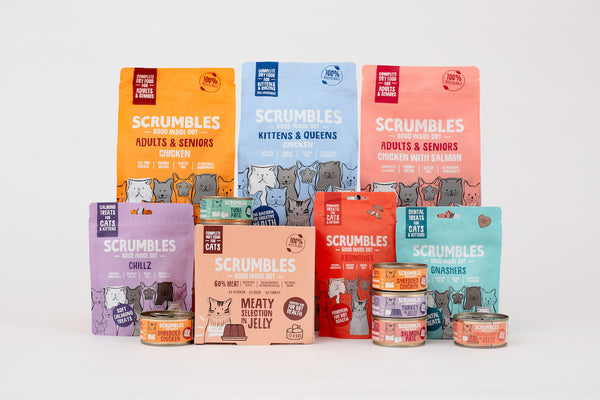Energetic | Tailless | Playful. With a tailless behind and a love of water sports, the Manx cat truly goes against the mould. They’re playful and follow their pawrents as if they were their own four-legged shadow. Read on to learn everything you need to know before you consider adopting one of these floofs and how Scrumbles can help you out!
MANX CAT BASICS
Average Lifespan: 10 – 14 years
Average Weight: 3.5 – 5.5kg
Coat Length: Short and long (also known as the Cymric breed)
Colouring: All colours and combinations
Shedding: Moderate

WHAT IS THE ANCESTRY OF THE MANX CAT?
Tailless Manx cats are endemic to the salty shores of the Isle of Mann and have been strutting their bare bottoms on the island since the 1700s. These kitties are so adored by the people of the Isle of Man that they’ve become the unofficial symbol of the island and are featured in artwork, stamps and even their 10 pence coin.
The cause of their tailless bums has been mystified in folklore throughout the ages with some stories going as far as telling of their tail being chopped off by the door of Noah’s arc. In reality, the cause of their unique derriere is due to a dominant genetic mutation which is passed down to any kitten who has a Manx parent.
There are both short and longhaired variants of the Manx with the latter recognised as its own breed by the GCCF known as the Cymric.
WHAT DO MANX CATS LOOK LIKE?
The Manx cat is best known for its tailless appearance, however, some of these kitties possess teeny weeny or even normal-sized tails. The Manx people have a variety of names to refer to the different-sized tails, ranging from the “Rumpy” tailless Manx, to the “Stumpy” partial-tailed cats and “Longy” normal-sized tails. All of these floofs have strong hind legs which makes them excellent jumpers, and full rounded faces with chubby cheeks, purrfect for smushing with lots of cuddles and kisses.

WHAT’S THE PURRSONALITY OF A MANX CAT?
The Manx cat doesn't let their unique appearance make them self-conscious. These kitties are confident and highly sociable and enjoy the company of other floofs as well as hoomans, giving doggies a run for their money in the competition for man’s best friend.
With origins as hunting cats, plucking tasty fish from the oceans of the Isle of Man and helping sailors rid their decks of pesky rats, Manx cats love to play and show off their running, jumping and pouncing skills. With their strong hind legs, they make proficient climbers, often surveying their hoomans preparing their tasty dinner from on top of kitchen cupboards. With a peculiar enjoyment of water, don’t be surprised if these kitties follow you to the bathroom, pawing at the running tap or popping their head under for good measure.
WHY DO MANX CATS NOT HAVE TAILS?
Despite there being a number of tales (pardon the pun) for the Manx cat’s lack of tail, the real reason is due to a genetic mutation that causes a shortening of the tail and spinal cord. This is a dominant trait, meaning if a kitten has just one Manx parent they will inherit the trait.
If two Manx cats have a litter and both pass this genetic mutation down, a form of spina bifida called Manx syndrome can develop causing issues with urination and defecation as well as abnormal movement or paralysis of their hind legs. Manx syndrome should be picked up before a kitten is 6 months old, so it’s best to avoid adopting a Manx cat younger than this and ensure your breeder is registered with the GCCF and can provide health guarantees.

MANX CAT FEEDING REQUIREMENTS
Manx cats require a nutritionally balanced diet consisting of protein from animal meat, vitamins, minerals, fats, water and a small amount of digestible carbs such as rice. Like all cats, they are obligate carnivores so the ingredient that should make up the largest proportion of their food should be animal meat in order to provide them with the necessary amino acids they need to live long and floofy lives. From there, whether their dinner comes from a dry cat food, wet cat food or a mixture of the two is up to their own purrsonal preference.

SCRUMBLES, THE PAWFECT MATCH FOR MANX CATS
Scrumbles is the pawfect choice for Manx cats because:
- We’re All About Meat and Gut Health: We know that cats require a diet high in animal meat to thrive. That’s why we load our cat food recipes with up to 77% poultry or fish to provide Manx cats with the essential nutrients they need to live long into their nine lives. We’re also big on gut health and pretty poops so we use gut-loving prebiotics or probiotics to strengthen healthy digestion and reduce tummy upsets.
- We Avoid Common Allergens: Some Manx cats are more sensitive than others and require a little extra TLC. That’s why we avoid common allergens including dairy, soy, gluten and egg which are known to upset kitty-cat tums.
- We Use Ethically Sourced + Natural Ingredients: You’ll never see any artificial additives or preservatives or added salt or sugar in our recipes which are unhealthy for cats and known to upset tums. Our ingredients are ethically sourced and 100% natural.
- Certified Delicious: With nearly 5000 five-star reviews from British kitties who love the taste of our cat food there’s sure to be a recipe for even the fussiest of felines.
- We Care About The Planet: Choosing your fur baby’s dinner shouldn’t cost the planet. We use eco-friendly packaging and source our poultry from British farms, to cut down on food miles and reduce our carbon footprint on this Earth.
Whilst you're here, why not read:
- Siberian Cat Breed
- Ragdoll Cat Breed Guide
- 5 Cat Calming Tips to ease anxiety


